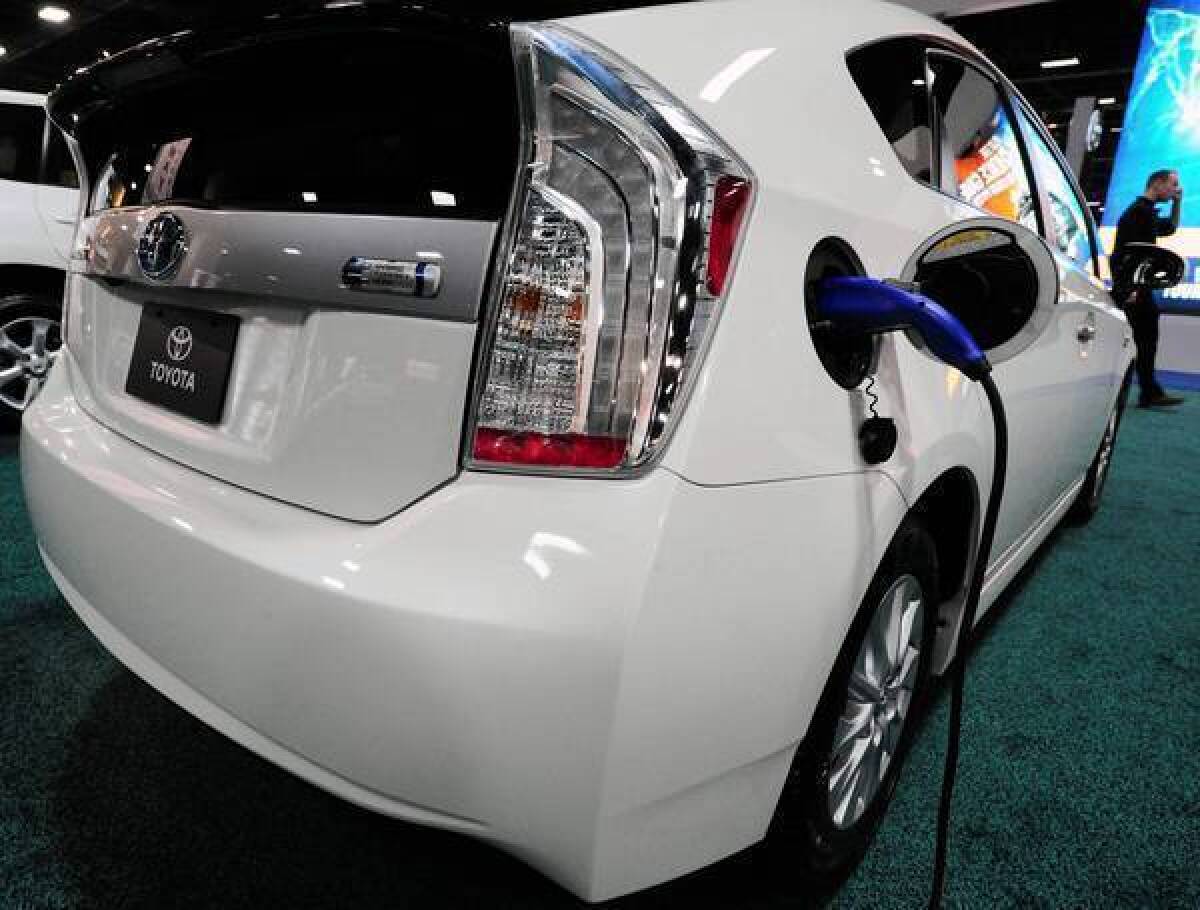Plug-in hybrid sales soar; all-electric cars stay in low gear

- Share via
Since a new generation of electric cars went on sale 18 months ago, the results have been far from jolting.
Sales of what are considered “pure” electric cars — they run off just a battery — have risen to slightly over 4,100 during the first six months of this year, up just 6% from the same period a year earlier, according to auto information company Edmunds.com.
The gain, which amounts to just 234 cars, comes even though Ford, BMW, Honda and Mitsubishi all have joined pioneer Nissan in offering electric vehicles. Analysts say electric cars’ limited range and higher prices, as well as the lack of a widespread public charging infrastructure, have hurt the appeal of the vehicles. The pure electric cars have no back-up to power them when their batteries run out.
“Range anxiety just kills it for a lot of day-to-day consumers,” said Ivan Drury, an analyst with Edmunds.com.
But sales of plug-in hybrids — vehicles that can travel some miles on battery power before a traditional gasoline engine kicks in — are soaring.
Thanks to a resurgent Chevrolet Volt and Toyota’s introduction of a plug-in version of its popular Prius, sales of such vehicles have jumped 381% to more than 13,000 in the first half of this year, according to Edmunds.com.
“A lot of consumers believe an ideal vehicle might be an all-electric, but the distance they drive might be greater than what an electric can handle,” said Michael O’Brien, the electric and hybrid vehicle marketing chief atFord Motor Co.
On Friday, Ford announced the range of its first plug-in hybrid — the C-Max Energi small crossover, which comes out later this year.
It will be able to travel about 20 miles on electricity alone but could go an additional 530 miles with the help of its gasoline engine, Ford said. That would make the C-Max one of a handful of vehicles and the only rechargeable auto that could drive from Sacramento to San Diego on a single tank of gas.
The automaker declined to say what it plans to charge for the C-Max, which is expected to qualify for a $1,500 California rebate and carpool lane permits.
Ford is looking at the sales number for other plug-ins this year and is liking what it sees.
General Motors Co.has sold 8,817 Chevrolet Volts in the first half of this year, a 221% increase. That includes 1,760 sold in June. Volt sales have been helped by the car’s recent qualification for the California rebate and carpool lane permits. About 28% of its sales last month were in California.
Toyota Motor Co.has sold 4,374 of its Prius plug-ins through June, about 60% in California. The company has forecast that it will sell about 15,000 Prius plug-ins this year.
By comparison,Nissan Motor Co.sold only 3,148 all-electric Leafs in this year’s first half, down 18.8% from a year earlier. Just 535 of those sales took place last month.
Mitsubishi has sold 333 of its i-MiEV electric-only car.
“The battery electric solution that is 100% gasoline-free really caters to a small audience because of the limited range of those vehicles,” O’Brien said.
Conventional hybrids, like the original Prius, route energy — much of it generated when the vehicle brakes — into a battery. They use that electricity to power an electric motor to get the car moving from a stop and to assist in accelerating, passing or hill climbing, all areas in which cars burn up the most gas, which is why they get terrific fuel economy.
However, they don’t give drivers the option of driving gas-free.
Plug-in hybrids enable car owners to straddle both worlds.
“It is the best [electric] option right now because they overcome the idea that you can’t drive the vehicle past a 75- or 80-mile limit,” Drury said.
He believes plug-in hybrid sales will grow to 40,000 to 50,000 vehicles in 2013, but that their price — higher than that of a conventional hybrid — will remain an obstacle to faster growth.
“Plug-ins are in their early stages, similar to the first years of conventional hybrids,” he said.
As more companies come out with plug-ins — look for versions of the Ford Fusion andHonda Motor Co.’s Accord in the next year — the debate will turn to what is the best electric-only range for these vehicles.
Toyota’s plug-in Prius checks in with an 11-mile electric range, according to the Environmental Protection Agency. The Volt gets 35 miles. (Individual drivers might do better or worse. The numbers are just guidelines.) Ford says the 20-mile electric range of the C-Max is a sweet spot that can cover most one-way commutes and allow the driver to charge up for the return home.
More to Read
Inside the business of entertainment
The Wide Shot brings you news, analysis and insights on everything from streaming wars to production — and what it all means for the future.
You may occasionally receive promotional content from the Los Angeles Times.











